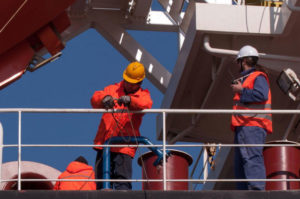Quicker Return to Fit for Duty Status

Quicker Return to Fit for Duty Status
Crew members spend more time than necessary dealing with shore side medical care. Many things can be done to improve the efficiency of shore side care. This article provides specific recommendations to expedite U.S. shore side care and quickly return a crewmember to fit for duty status.
Communicate While at Sea
Even before a ship arrives at its intended or nearest port-of-call, a key step can be taken to increase the likelihood that an injured or ill crew-member can return to fit for duty status relatively quickly. Specifically, it is important to seek medical advice via e-mail or radio with a medical provider – e.g. a physician or nurse. Medical providers will describe the best course of treatment that can be achieved while the crew-member is still at sea. Such treatment will typically be relatively easy to implement, such as crew-member immobilization, ice treatments, use of anti-inflammatory medications, and adequate rest.
Make Medical Appointments Prior to Arriving in Port
If, two days in advance of port arrival the crew-member is still being adversely impacted by their injuries, or still has illness symptoms, it is important to schedule a land-based medical appointment to take place as soon as possible. Such medical appointments can be made by making requests to a medical manager. With up-to-date information about the crew-member’s medical condition and the ship’s arrival schedule, the medical manager will schedule an appointment with the appropriate medical facility, physician, or medical specialist. Keep in mind that if the crew-member’s condition improves before the ship arrives in port, the medical appointment can be easily canceled.
Waiting until the vessel arrives to make medical arrangements can result in the use of hospital emergency rooms, which (as will be described below) are expensive and problematic for quick return to fit for duty status.
Share Work & Schedule Information with Physicians and Medical Managers
Before the crew-member’s medical examination and treatment, it is important to provide U.S. physicians with information about the crew-member’s responsibilities. In particular, such information should focus on flexibility in the crew-member’s work duties. The more that U.S. physicians understand about flexibility in crew-member’s duties, the more options they have in terms of granting fit for duty status. Examples of such flexibility include:
- Indicating that the crew-member’s responsibilities allow for light duty restrictions or modifications (e.g. 2-hour work shifts with intermittent work breaks).
- Explaining that the crew-member’s responsibilities mainly consist of bridge duty, for which remaining seated is acceptable.
- Indicating if bedrest can be accommodated by vessel
Additionally, it is important to share the ship’s port-of-call schedule with U.S. physicians. As U.S. physicians typically do not have confidence in other countries’ medical infrastructures, it is beneficial to share with them any near-term visits to U.S. ports of call. With such information, U.S. physicians will gain confidence that adequate follow-up medical care can be provided, and will more likely approve fit for duty status. Even if the crew-member is not fit for duty, U.S. physicians may grant a “fit to sail” status. In this case the crewman is able to return to the ship, keeping it in compliance with its crewing certificate. Fit to sail status provides time for owners to locate and onboard replacement crew, often reducing costs surrounding immediate repatriation.
Points to Remember
SphereMD recommends sending the following information to your medical manager with every shore side crew member: job title, specific duties, next port, expected date of sign off, and accommodations available (examples above, such as light duty and modifications).
This information will assist your medical manager in working with U.S. physicians to ensure that the crew member’s and vessel’s needs and accommodation options are well-understood and taken into consideration. The end goal is to communicate the right information to provide the best care and an appropriate fitness determination.
Choose the Right Medical Provider
It is well accepted that emergency rooms are an expensive, inefficient venue to receive non-emergent care, and therefore should be avoided for routine cases. Further, emergency rooms in the U.S. tend to issue more restrictive fit for duty statuses, and require follow-up that doesn’t consider the movement of ship. Emergency rooms are often unwilling to complete ship medical paperwork, as they are not required by U.S. law to do so. Sometimes, emergency room physicians omit any mention of fit for duty status, which means that those physicians must be re-visited (requiring extra time, paperwork, and costs to request fit for duty status).
The best way to avoid emergency rooms and find the right medical provider in each port is to work with a medical manager. Medical managers will ensure that the crewmember is taken to the right physician (e.g. an eye doctor for an eye injury) or to a clinic if a specialist is not required. Not only can clinics cover the majority (90%) of emergent or non-urgent care, they also provide quick service and are willing to fill out ship medical paperwork. By being proactive with care and utilizing medical management services, you can have better control over crew member medical care in the U.S. You will decrease costs, protect vessel schedules, and enjoy more effective medical care.

